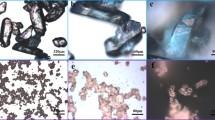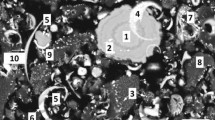Abstract
Thermal destruction of indium and dysprosium hydroxides coprecipitated from solutions of their nitrate and chloride salts with ammonia was investigated by DTA/TG, XRD and MS methods. The features of these processes were revealed in solutions of different nature. It is shown that the method of thermal decomposition of mixed indium and dysprosium hydroxides coprecipitated from the solution of their chloride salts is environmentally appropriate and economically viable. The size of the coprecipitated hydroxide particles of indium oxide produced through thermal destruction at up to 500 °C (13 nm) allows us to recommend this method for production of nanodispersed mixed oxides of indium and dysprosium.











Similar content being viewed by others
References
Kment S, Hubicka Z, Krysa J, Sekora D, Zlamal M, Olejnicek J, Cada M, Ksirova P, Remes Z, Schmuki P, Schubert E, Zboril R. On the improvement of PEC activity of hematite thin films deposited by high-power pulsed magnetron sputtering method. Appl Catal B Environ. 2015;165:344–50.
Sirghi L. Plasma synthesis of photocatalytic TiOx thin films. Plasma Sources Sci Technol. 2016;25(3):033003.
Rodriguez JA, Fernandez MG. Synthesis, properties and applications of oxide nanoparticles. New Jersey: Whiley; 2007.
Fernandez MG, Martinzes AA, Hanson JC, Rodriguez JA. Chem Rev. 2004;104:4063–104.
Tietz H. Technical Ceramics. Düsseldorf: VDI Verlag; 1994.
Ming-Wei Wu, Pang-Hsin Lai, Chia-Hong Hong, Fang-Cheng Chou. The sintering behavior, microstructure, and electrical properties of gallium-doped zinc oxide ceramic targets. J Eur Ceram Soc. 2014;34(15):3715–22.
Ikesue A, Kinoshita T, Kamata K, Yoshida K. Fabrication and optical properties of high-performance polycrystalline Nd:YAG ceramics for solid-state lasers. J Am Ceram Soc. 1995;78(4):1033–40.
Yagi H, Yanagitani T, Numazawa T, Ueda K. The physical properties of transparent Y3Al5O12 elastic modulus at high temperature and thermal conductivity at low temperature. Ceram Int. 2007;33(5):711–4.
Merrilea Joyce Mayo. Processing of nanocrystalline ceramics from ultrafine particles. Int Mater Rev. 1996;41(3):85–115.
Zhukov I, Vorozhtsov S, Promakhov V, Bondarchuk I, Zhukov A, Vorozhtsov A. Plasma-chemical method for producing metal oxide powders and their application. J Phys: Conf Ser. 2015;652:012027.
Kuzjukevics A, Linderoth S, Grabis J. Characterization of yttria-doped zirconia powders produced by plasma-chemical method. Solid State Ion. 1996;92(3–4):253–60.
Nomoev AV, Bardakhanov SP, Schreiber M, Bazarova DZ, Baldanov BB, Romanov NA. Synthesis, characterization, and mechanism of formation of Janus-like nanoparticles of tantalum silicide-silicon (TaSi2/Si). Nanomaterials. 2015;5(1):26–35.
D’Amato R, Falconieri M, Gagliardi S, Popovici E, Serra E, Terranova G, Borsella E. Synthesis of ceramic nanoparticles by laser pyrolysis: from research to applications. J Anal App Pyrolysis. 2013;104:461–9.
Borsella E, Botti S, Fantoni R, Alexandrescu R. Composite Si/C/N powder production by laser induced gas phase reactions. J Mater Res. 1992;7(8):2257–68.
Kotov YA, Osipov VV, Ivanov MG, et al. Properties of YSZ and CeGdO nanopowders prepared by target evaporation with a pulse-repetitive CO2-laser. Rev Adv Mater Sci. 2003;5:171–7.
Gulyaev I. Experience in plasma production of hollow ceramic microspheres with required wall thickness. Ceram Int. 2015;41(1):101–7.
Szépvölgyi J, Károly Z. Preparation of hollow alumina microspheres by RF thermal plasma. Key Eng Mater. 2004;264–268:101–4.
Ghyngazov SA, Frangulyan TS. Impact of pressure in static and dynamic pressing of zirconia ultradisperse powders on compact density and compaction efficiency during sintering. Ceram Int. 2017;43(18):16555–9.
Mironov V, Stankevich P, Beljaeva I, Glushenkov V. Static-dynamic powder material compaction methods. Eng Rural Dev 2016;15:1128–32.
Boltachev GSh, Nagayev KA, Paranin SN, Spirin AV, Volkov NB. Magnetic pulsed compaction of nanosized powders. New York: Nova Science; 2010.
Khasanov OL, Pokholkov YuP, Ivanov YuF, Ljubimova LL, Makeev AA. Effect of ultrasonic compaction of nanopowder on structure and fracture character of zirconia nanoceramics. Fract Mech Ceram. 2002;13:503–12.
Lukianova OA, Novikov VYu, Parkhomenko AA, Sirota VV, Krasilnikov VV. Microstructure of spark plasma-sintered silicon nitride ceramics. Nano Res Lett. 2017;12:293.
Surzhikov AP, Franguljyan TS, Ghyngazov SA, Vasiljev IP, Chemyavsky AV. Sintering of zirconia ceramics by intense high-energy electron beam. Ceram Int. 2016;42(12):13888–92.
Vayos G Karayannis. Microwave sintering of ceramic materials. In: IOP conference series: mater science and engineering. 2016;161(1):012068.
Anand K, Thangaraj R, Kohli N, Singh RC. Structural, optical and ethanol gas sensing properties of In2O3 and Dy3+: In2O3 nanoparticles. 58th DAE Solid State Physics Symposium (DAE SSPS-2013). 2014. https://doi.org/10.1063/1.4872645.
Trusova EA, Khrushcheva AA, Vokhmintcev KV. Sol-gel synthesis and phase composition of ultrafine ceria-doped zirconia powders for functional ceramics. J Eur Ceram Soc. 2012;32(9):1977–81.
Egorov YP, Malinovskaya TD, Naiden EP, Sachkov VI, Sachkova EI. Chem Sustain Dev. 2002;10:679–85.
Inoue K, Tanaka N, Tanaka T. Lanthanoid-containing oxide target. Patent US, No. 8,038,911 B2, 2011.
Inoue K, Yano K, Kasami M. Sputtering target, oxide semiconductor film and semiconductor device. Patent US, No. 8,333,913 B2, 2012.
Wei Ruichao, Huang Shenshi, Huang Que, Ouyang Dongxu, Chen Qinpei, Yuen Richard, Wang Jian. Experimental study on the fire characteristics of typical nitrocellulose mixtures using a cone calorimeter. J Therm Anal Calorim. 2018;134(3):1471–80.
Souri D, Shahmoradi Y. Calorimetric analysis of non-crystalline TeO2-V2O5-Sb2O3. J Therm Anal Calorim. 2017;129(1):601–7.
Brazolin GF, SilvaL CCS, Silva S, Silva RAG. Phase transformations in an annealed Cu–9Al–10Mn–3Gd alloy. J Therm Anal Calorim. 2018;134(3):1405–12.
Hinatsu Yukio, Doi Yoshihiro. Synthesis of new fluorite-related rare earth oxides LnLn2′MO7 (Ln, Ln′ = rare earths; M = Nb, Sb, Ta), their structures and magnetic properties by calorimetry measurements. J Therm Anal Calorim. 2017;127(1):749–54.
Brinker CJ, Scherer GW. Sol-Gel Science. The physics and chemistry of Sol-Gel processing. Academic Press, INC; Am Imprint of Elsevier; 1990. 908 p.
Acknowledgements
The results were obtained within the framework of the state task of the Ministry of Education and Science of the Russian Federation, Project No. 16.3037.2017/4.6.
Author information
Authors and Affiliations
Corresponding author
Additional information
Publisher's Note
Springer Nature remains neutral with regard to jurisdictional claims in published maps and institutional affiliations.
Rights and permissions
About this article
Cite this article
Malinovskaya, T., Ghyngazov, S. & Zhek, V. Thermal destruction of coprecipitated hydroxides of indium and dysprosium. J Therm Anal Calorim 138, 1871–1877 (2019). https://doi.org/10.1007/s10973-019-08261-1
Received:
Accepted:
Published:
Issue Date:
DOI: https://doi.org/10.1007/s10973-019-08261-1




